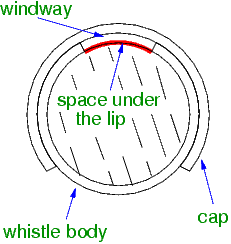The "Low-Tech" Whistle: How to Make a PVC Whistle
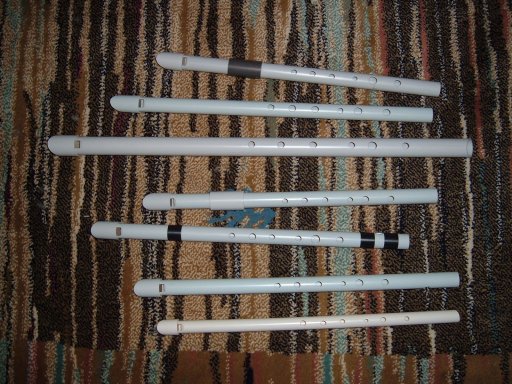
|
|
A PDF version of this guide is available here.
Brazilian translation here, thanks to Adriano Soriano Caetano.
Spanish translation here, thanks to Germán García
Sticky. I have too little time and too many things to do. Sorry, but I have decided not to reply to email regarding whistle making any more. All I know is in this guide, and I think this guide is clear enough :-) Updates (if any) will only cover new or updated whistle plans. If you need help, please go to Chiff and Fipple. Sorry folks, but I'm overwhelmed!
Introduction
I attended my first tin whistle workshop on St. Patrick's Day Festival 2004, where Inis Fail's Luca Crespi taught me the golden rule: it must not be played like a recorder...
Like many beginners, I suffered from Whistle Obsessive Acquisition Disorder. The problem was, I couldn't find a whistle I really felt comfortable with. How can you possibly play an instrument you don't like?
In my view, the reason for WOAD is twofold. First of all, the poor quality of many low-cost whistles: you're forced to try out several whistles until you're lucky enough to find a good one. Secondly, I found out that whistles are not like recorders, which more or less share a similar sound. A Susato Kildare, a Dixon polymer and a Clarke Sweetone are completely different instruments, each with its own character and peculiarities.
Another problem is that I have a good musical ear, and I can't stand badly tuned instruments. This is often an issue with low-cost whistles.
I live in a smallish town in northern Italy, Verona (ring a bell? Shakespeare, Romeo and Juliet, the Two Gentlemen...), where the tin whistle is virtually unknown. Even Generations are difficult to find. When I eventually stumbled across one, it was a horribly out-of-tune, shrill, squeaky thing that put me off. I brutalised it until I made it playable, but I wanted something better.
I was forced to order my whistles abroad, without a chance to try them out beforehand. Very annoying.
Make One Yourself
I'll save you the sad story of a year spent trying to get a whistle I liked. At the end of that year, I was nearly satisfied with a Dixon Polymer, a Susato Kildare, a Clarke Sweetone and a Meg.
The Dixon has a lovely tone but, in my humble opinion, is a bit too quiet in the first octave. The Susato is loud, but it sounds too much like a recorder! (I actually love recorders, but that's another story.) Both are reasonably in tune, but they could be better. I didn't like the sound of the Sweetone back then; now I do, but tuning is still an issue.
I wanted a whistle that was sweet and easy to play like a Dixon, but louder and cheap. Unfortunately, I couldn't find it. (Yes, I'm a fussy kind of person...)
A recent addition to my collection is the Dixon Trad. What a fantastic whistle! Had it been available back then, I probably wouldn't have tried to make my own. Read on, though...
Driven by frustration, I decided I'd try and make a whistle myself. However, I had no power tools like a drill, a bench vise, a lathe and what have you. Besides, most whistle making tutorials assume that you use copper pipe: hard luck, without proper tools! PVC is widely available though, so I decided I'd give it a try.
After some experiments (all of which, amazingly, produced playable whistles), I came up with a design that is easy to reproduce and works very well. I call it the `Low-Tech Whistle' because I only use very simple tools and materials.
Low technology, but high quality sound! Low-Tech Whistles in the key of D boast the following features:
- are very easy to play
- have a sweet tone, very similar to that of a Dixon Polymer; but you can make it breathy if you wish
- the volume can be made constant between the two octaves
- require little air; I estimate at least 25% less than other whistles
- the notes in the second octave don't need tonguing; but of course you may tongue if you prefer
- C natural can be obtained with both oxx ooo and oxx xox
- in addition to D and G, can also play in A without half-holing: G# can be obtained with xxo xxx (first octave) and xxo xox (second octave). Besides, Bb can be obtained with xox xxo (first octave) and xox ooo (second octave)
- are almost unbreakable: won't bend or crack even if sat on or stepped on
- unlike metal whistles, the tuning is less sensitive to temperature changes
- are ridiculously inexpensive, and fun to make!
Of course, there are defects, too:
- the gray-ish or white-ish colour of PVC is not particularly attractive, and black pipe is not easy to find;
- if wooden parts are used, the whistle could be clogged by moisture. There's a way to prevent this problem, though.
If you're dissatisfied with cheap whistles, try to make a Low-Tech whistle. I'm confident to say that you'll get a very nice instrument. Furthermore, the design is very forgiving: it's almost impossible to fail.
Sounds too good to be true? Don't take my word for it, try it yourself!
The great thing about making your very own whistle is that you can get it exactly how you like it. You can customise everything to suit your needs: hole placement, loudness, type of sound, tuning. Moreover, you can't imagine the feeling when you realise that you've built an instrument that sounds better than several you find in shops!
Materials and Tools
Here is the list of materials and tools you will need for a Low-Tech whistle in the key of D:
- about 40 cm of PVC pipe. Optimally, the bore (= internal diameter) should measure between 9 and 13 mm. The pipe thickness must not exceed 1.5 - 2 mm. A three-metre length cost me 2 Euros.
- a wooden or plastic stick that has the same diameter as the bore of your PVC pipe, or slightly more. Plastic is highly preferable, as it's impervious to moisture. A 1-metre beechwood stick cost me 0.5 Euro.
- scissors, or another pointed object. 1 Euro.
- medium and/or fine-grained sandpaper. 1 Euro.
- a cutter, or a very sharp small knife. 1 Euro.
- a hacksaw, one blade for metal and, if possible, one for wood. Alternatively, a kitchen jagged knife. 1 Euro.
- a ruler that measures in cm and mm. 1 Euro.
- a pencil. 0.2 Euro.
- (optional) white glue and adhesive tape. 1 Euro for both.
- (optional) a small file. 3 Euro.
- (recommended) a well-tuned musical instrument to tune your whistle against; good musical ear, or a friend who has. If you're a perfectionist (I am), a chromatic electronic tuner (around 20 Euro) or a tuner program for a smartphone.

In addition to the materials, you will need:
- a very little amount of craftsmanship. I'm usually awkward when it comes to making things: if I can make it, everybody can make it!
- at least one hour of your time, and no rushing. Haste makes waste, bad whistles, and even bleeding fingers.
All of these items are cheap and commonly available at hardware stores. Craftsmanship and patience are within your reach if you're, say, 12 or older.
The PVC pipe I use has external diameter (e.d.) = 16 mm, bore = 13 mm, wall thickness <= 1.5 mm. It is used for electrical conduits. I suggest that you do not use pipe with bore larger than 13--14 mm, unless you want to make alto or low whistles.
It doesn't matter if you use different pipe: just make sure that you use thin (less than 2 mm) and stiff pipe. In fact:
- the wall thickness defines the quality of sound. More than, say, 1.7 mm will make the whistle too breathy;
- soft or rubbery plastic will dampen the vibrations. As a result, the whistle will be too quiet or will sound dull.
I once thought that the material did not count that much, but evidence made me change my mind. Not all PVC pipes are created equal. I obtain consistently better sounding whistles using one brand, but you'll get reasonably good results with any brand of thin and stiff pipe.
Schedule 40 half-inch PVC pipe, commonly available in the U.S.A., might be too thick. Whistles made of this pipe are playable, but very breathy. Luckily, there's a solution; please see Dealing with Thick Pipe. Schedule 200 irrigation pipe is probably a better choice. Thanks to Floyd Brigdon for this information.
People also reported that CPVC pipe, used for hot water plumbing, works well. It's available at Home Depot and Lowe's stores.
In my opinion, using aluminium or copper pipe isn't worth the effort. They're much harder to work with, and you basically can't make a whistle unless you have power tools. Besides, I was given a couple of fine home-made aluminium whistles, and they sound exactly the same as my PVC whistles. (I expected them to be louder.)
Now you're ready to try this at home - better, in the garden or wherever it doesn't matter if you make a bit of a mess with PVC scraps and sawdust. But, beware:
Hacksaws, scissors and cutters have sharp blades. If you don't pay attention, you may slice your fingers: it hurts like hell. Take care, mind your fingers, wear protective gloves. And if you don't believe me, then ask my left thumb.
Also, do not breathe wood and PVC sawdust: I'm pretty sure it's not healthy.
PVC Health Issues
You should be aware that PVC might be dangerous for your health. Please have a look at the Wikipedia page on PVC.
However, I talked to a chemist friend of mine and asked for his opinion on the matter. He said that all PVC pipes sold in Italy are chemically inert. They must be extremely stable, as they must last decades embedded in walls. Therefore, it's very unlikely that a whistle made with this PVC will release nasty chemicals.
So, I assume that using PVC for whistles is pretty safe. Besides, all PVC, ABS and in general plastic whistles on the market don't ship with a health certificate, do they?
How to Get your Favourite Sound
The following figure shows the names of whistle parts:
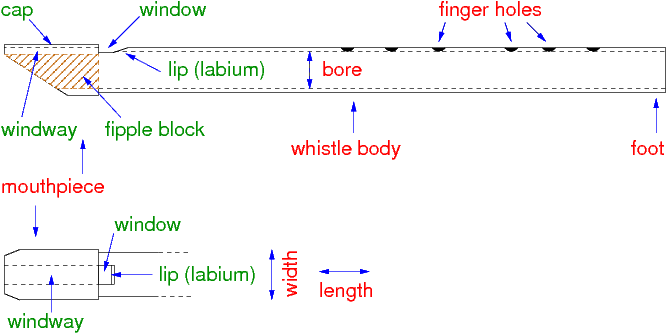
The most important part of a whistle is the mouthpiece. Its dimensions define the sound of the whistle:
- a short mouthpiece (e.g. 20 mm) makes for a highly responsive whistle, but consumes slightly more air;
- a long mouthpiece (e.g. 30 mm) provides some backpressure and needs less air, but makes the whistle less responsive;
- a wide windway (e.g. 10 mm) makes the whistle louder, the sound becomes a bit breathy, and more air is needed;
- a narrow windway (e.g. 7 mm) makes the whistle quiet, the sound becomes sweet and clear, and less air is used;
- a short window (e.g. 3 mm) makes notes in the second octave easier to play, while making first octave notes softer;
- a long window (e.g. 5 mm) makes notes in the first octave more solid, but notes in the second octave need some push;
- tiny variations in the windway height - tenth of a mm! - have a dramatic effect on the sound: the higher, the breathier.
Take this information into account when you decide what your whistle will sound like.
Other factors influence the whistle volume. Big holes make the whistle loud, small holes make it quiet. A whistle with a small window and big holes will sound louder and sweeter than a whistle with a big window and small holes. Blowing harder also increases the volume and sharpens the pitch! When you tune the whistle (see below), you'll have to decide how hard to blow it.
For any given pipe bore, the lower the key (that is, the longer the pipe), the quieter the whistle. Instead of just enlarging the windway, you should experiment on the width-to-length ratio of the window. For example, on a C whistle an 8 x 5 mm window produces a much better sound than a 10 x 4 mm window.
My favourites D whistles have a 20-mm-long mouthpiece and a 7.5 x 4 mm window. The tone is sweet, the volume is fairly loud, and the two octaves are well balanced.
The Art of Tuning
Let me start this section with a witty remark by whistle teacher Brother Steve:
...in general, people with perfect pitch do not take up the tin whistle!
The same concept is stressed upon by a renowned flute maker, Doug Tipple, who writes in his flute pages:
I believe that some people have unreasonable expectations about pitch and intonation. They think that their $20 electronic tuner set to equal-temperment is the gold standard and that any variation from ``dead-on'' pitch accuracy is not acceptable. To the contrary, my attitude with regard to flute performance is to lay perfectionism aside and accept some variations in intonation as inescapable and perhaps even a good thing.
I quote these wise words completely. In fact:
Due to the physics of the instrument and the way it's played, cylindrical whistles cannot be exactly in tune. And don't complain: uncorrected cylindrical flutes are even worse, not to talk of bagpipes.
First of all, the player's blowing pressure can alter the pitch of a note by a third of a tone, or even more. Secondly, with cylindrical whistles the second octave is slightly flatter than the first octave. Third, the whole tuning is affected by air temperature.
Fourth, and this may sound strange to you: a few notes should be tuned purposedly flatter than their "right" pitch (G and C sharp on D whistles, for instance). This way they will sound better. It's a complex subject called temperament.
All this blurb to support my opinion: checking each note on a chromatic tuner is not a great deal. I suggest that you use the tuner for only one note: the key note of the whistle in the second octave. For example, the second D on whistles in the key of D; you'll tune the other notes by ear. Trust your ears! Take your favourite blowing pressure into consideration, and warm up the whistle for at least 20 seconds beforehand.
Finally, bear in mind that high-pitched notes stand out much more than lower-pitched notes. While flat high notes sound really horrible, sharp low notes may go nearly unnoticed. Keeping all this in mind, you may want to tune the second octave D (or the equivalent base note) just a bit sharp, e.g.\ 5 cents. The second octave will sound in tune, the first octave will sound slightly sharp.
Whistle Plans
A first approximation of the hole positions is given by the following table. It specifies the hole positions as a percentage of the lip-to-foot length, calculated from several soprano D whistles I made. For example, the first value (42%) is calculated as:
distance of first hole from the lip / lip-to-foot distance.
| top hole | 42-43% |
| 2nd hole | 50-51% |
| 3rd hole | 58-59% |
| 4th hole | 67-68% |
| 5th hole | 72-75% |
| bottom hole | 83-84% |
This table is just a rough approximation! Actual hole positions may differ by several millimeters! Besides, different tables apply for soprano, tenor and low whistles. As far as I know, there is no "perfect" formula as there are many factors involved.
In the following plans, all measurements were calculated for whistles whose central note is exactly on pitch. Unit is millimeters. Click on the images to download a PDF version of the plan.
If you want a session-grade whistle you can blow harder, add 2 mm to each figure. That is, add 2 mm to the whistle length and 2 mm to the distance of each hole from the lip.
Here's a mm-to-inches chart, kindly provided by Stuart Wier:
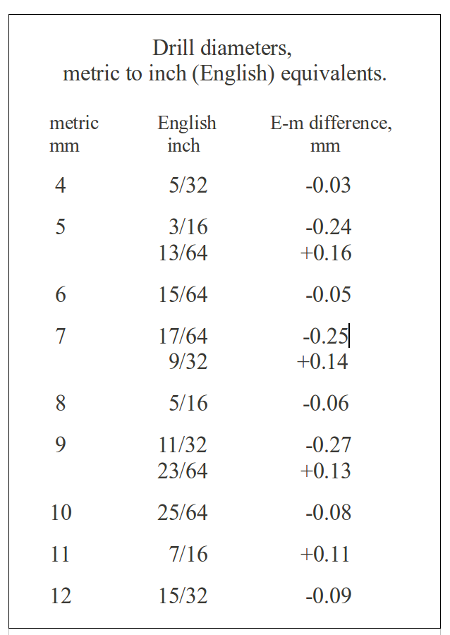
By request, here is a "whistle-chanter" in Bb. It is designed to be played using the same closed fingering as a GHB chanter:
(it sounds awful: don't even think about replacing a real chanter with this ugly thing.)
These whistles in the key of D provide an additional bottom hole for playing C sharp or C natural. Beware: the bottom D is weaker than in a standard whistle!
Starting from the key of C, you will want to use pipe of wider bore (I switch to 20 mm e.d. pipe). Conventionally, whistles in the key of Bb down to G are called "Alto whistles". Wider-bore whistles are louder and have a much stronger bottom note, if you rig the fipple as explained in Section Rigging the Fipple:
Still wider bore is required for Low whistles, which conventionally start from the key of F down to low C or even Bb. Moreover, the window should be enlarged a bit. I use 25 mm e.d. pipe.
The following table provides the hole positions for low whistles, as obtained from my low D:
| top hole | 45% |
| 2nd hole | 52% |
| 3rd hole | 59% |
| 4th hole | 69% |
| 5th hole | 75% |
| bottom hole | 83% |
This picture shows a low C, a low D, and a soprano D whistle:
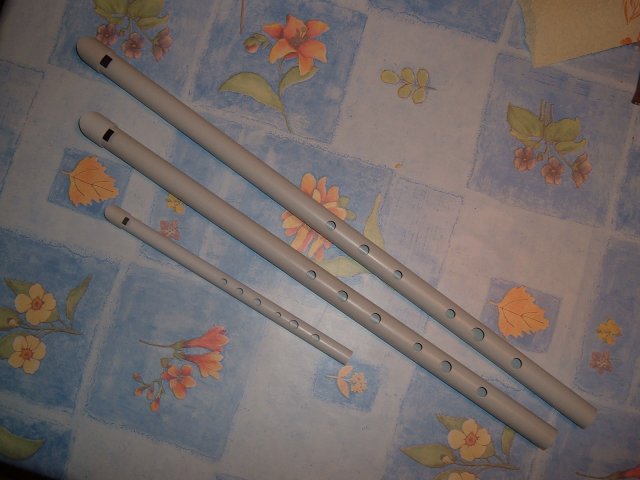
This is the fingering chart for the model in the key of D (PDF version here):
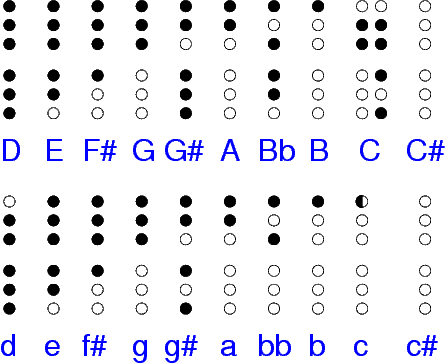
These measurements are not carved in stone. Other factors may influence the tuning, such as pipe thickness, type of PVC, window size. Please take them with a pinch of salt. In particular: if the bore of your pipe is less than 13 mm, the whistle will be a few millimeters longer; and vice versa.
To some extent, the hole positions and diameters may vary. I'll give you the measurements I chose for my own convenience, but feel free to experiment. The basic rule is: if you move a hole upwards (i.e. closer to the mouthpiece), you'll have to reduce its diameter; and vice versa. This rule allows you to adjust the holes' positions in order to make the whistle more comfortable to your hands. Besides, if you make a mistake positioning a hole you'll be able to correct it by varying its diameter.
Have a look at these two whistles. They are tuned exactly the same, but one has a small window, small holes and is even shorter than the other. It's a quiet whistle, and I call it the `lager' as opposed to the `stout', that is a louder whistle. Notice that the holes are placed differently in each whistle.

Lastly: your first whistle will probably take more time to make than the second. Don't worry, don't rush. Have fun.
Roll Up Your Sleeves
The following instructions assume that you are going to make a standard whistle in D, with a 3-cm-long mouthpiece. If you want to make a whistle in a different key, the only difference is the length of the initial PVC piece. For instance, if you want to make a C whistle, the pipe will be 3.5 cm longer.
Please bear in mind that boring the holes is the easiest part of the job. The tricky part is making the mouthpiece! Also, do not take measurements from the pictures; use the drawings above.
I suggest that you read all the instructions before you start. All pictures were taken during the actual construction of a whistle.
First of all, you will want to make square cuts. It's fairly simple:
- Mark the distance where you will cut the pipe.
- Roll some tape around the pipe, close to the mark. Make sure the tape ends overlap perfectly. The tape will act as a guideline.
- Start cutting along the tape, roll the pipe forward a bit, cut some more, and so on.
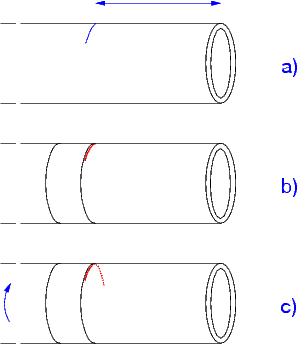
And now, go ahead!
- saw off a 30.5-cm-long piece of PVC pipe, a 3-cm-long piece out
of the wooden stick, and a 3-cm-long piece of PVC pipe. These pieces
will become the whistle body, the fipple block, and the windway top.
When sawing the fipple block and the windway top, make one end at an
angle of approximately 45 degrees or less. (Just aim at 45 degrees,
the angle doesn't really matter.)

After sawing the PVC pieces to measure, make all ends, edges and sides smooth and well polished.
- Using the file or the sandpaper, adjust the diameter of the
fipple block until it fits perfectly and with very
little resistance into one end of the whistle body. Put special
care into making the fipple block perfectly cylindrical! Optionally,
the top could be shaped as shown in the figure below. As indicated,
do not bevel the fipple edge! This would alter the sound in
a hard-to-control way. Bevelling the fipple is required for alto and
low whistles, not sopranos.
Remember, the fipple block is the most important piece of your
whistle: the sound quality depends on how accurately you shape it.
If you make it wrong, never mind: toss it away and make another.
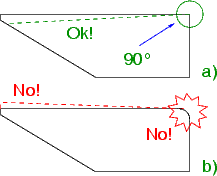
You may make the fipple block top parallel to the bottom, but if you make it tapered as shown by the green line in the drawing some Bernoulli effect will occur. That is, the air flow will accelerate near the lip, increasing the whistle responsiveness and lowering air requirements. It will produce some backpressure, too. Take care not to blunt the fipple end!
- Draw the whistle axis, i.e. a line from one end of the whistle body to the other. Try and make the axis perfectly parallel to the sides of the pipe.
- Measure 30 mm from one end of the whistle body along the axis,
and mark this distance; then draw two parallel lines 8 mm or 10 mm
apart. Saw off a 30 x 8 mm (or 30 x 10 mm) section. This slot will
become the windway; the shorter side (which is somehow tricky to
cut) will become the lip. It's very important that the slot sides be
straight. Do not exceed these dimensions.
I'll remind you again here. 8 mm wide windway = small window = less air required, quieter and pure sound; 10 mm wide windway = big window = more air required, louder and very slightly breathy sound. Your choice.

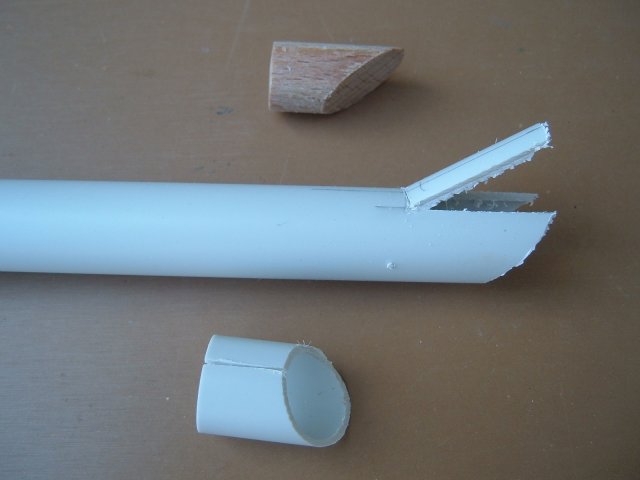
Again, make all edges perfectly clean. It is essential that you make the lower edge of the lip a perfectly clean and even arc. If you wish to apply the Bernoulli effect, the section to cut out should measure 10 (mouth end) x 8 (lip) mm.
- Cut out a small section out of the shorter side of the windway
top. Insert the fipple block so that its end stays 4-5 mm from the
lip. Snap the windway top into place, making sure its end is exactly
above the fipple block end or a little more advanced. The mouthpiece
is now ready to make a sound.
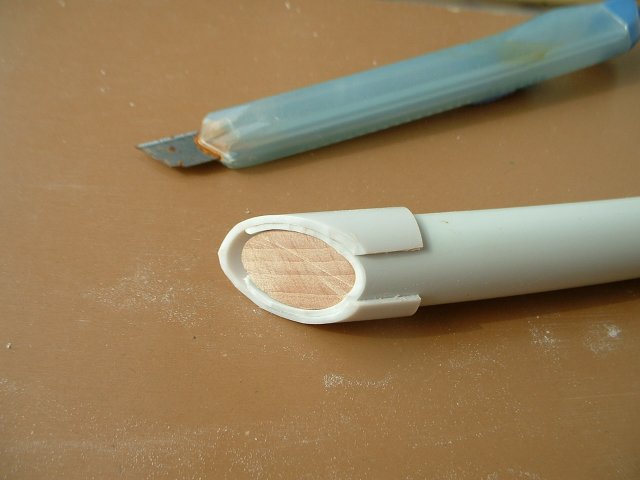
Peek through the windway: if the fipple block has the correct size, you should see a hairline space just below the lip - say, the thickness of two or three sheets of paper. If you don't see this little space, the sound will be weak; sand the top of the fipple block as needed. Beware not to sand too much, or the whistle will consume more air and the second octave will sound harsh. As little as 1 mm may be too much!
- Blow gently and you will hear a feeble D. Blow harder and
you'll get a flattish D one octave higher. Sand the upper edge of
the lip: the whistle sound will grow cleaner and louder. The lower
the angle, the better; try to aim at 30 degrees or less. The right
tool is a tiny file made with rolled-up sandpaper. Do not
touch the lower edge of the lip, which should not become sharp.
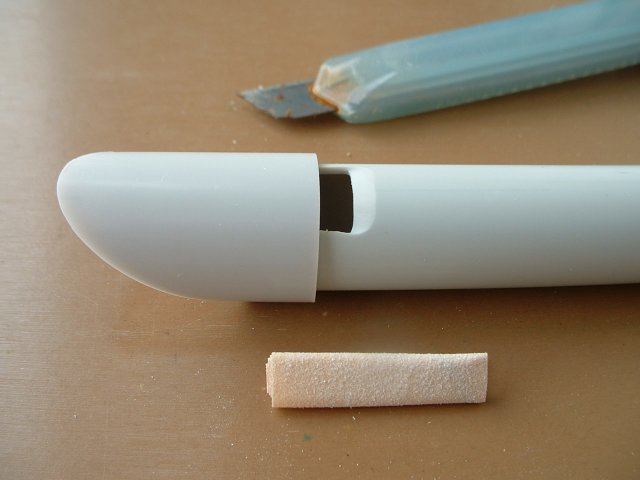
- Adjust the window size by moving the fipple block up or down.
- It's now time to tune the whistle; at this stage it should be producing a slightly flat D. Cover the window with your finger and blow for 20-30 seconds to warm up the whistle. Now shorten it until you blow a correct second octave D, cutting off 1 mm at a time from the foot. As I explained above, you may want to tune this note 10 cents sharp.
- Along the axis, mark the positions of the holes at the
distances indicated in the figure above.

- Bore the holes, starting from the bottom of the whistle. Use
the scissors' tip, twisting it in order to remove small amounts of
PVC. Work slowly. Blow and check every note until it sounds
OK; remember to check the notes on both octaves. The electronic
tuner helps a lot here. You'll have to make a trade-off between the
first and the second octave E; if the first is perfectly in tune,
the second will be flat. Work out an acceptable hole diameter.
If you bore only the bottom three holes, and move the third hole to the back, you make a tabor pipe.

- When you bore the last hole (the B hole), you have the chance to choose the fingering for C natural. Make the B hole a bit smaller and you'll get C natural with oxx ooo; enlarge it and C natural will be obtained with oxx xox. Make it right and you'll get a good C natural with both fingerings!
- Sand the lower side of the mouthpiece to make it even and
smooth.

- The whistle is almost finished. Now, give it the finishing
touches: make all holes perfectly smooth, sand the mouthpiece bottom
side, and make sure there is no sawdust and PVC bits left in the
mouthpiece. If your pipe is glossy and slippery, you may want to
sand it using extra fine-grained sandpaper.

- You've made it! Congratulations! Now, clean up the mess and go play your whistle for a while. You might find minor tuning imperfections that you can correct later on.
You may want to make two whistles with different sounds, which I call the `stout' and the `lager'. The `stout' whistle is loud (window dimensions: 8 x 5 mm), has some backpressure and is good for outdoors or session playing. The `lager' whistle has a more delicate sound (window dimensions: 7 x 3 mm) and it gives its best at playing airs.
To get a hint of their volumes, my `lager' is approximately as loud as a Sweetone, while my `stout' is almost as loud as a Susato. But it still sounds like a whistle...
Surely, now you want to hear what the Low-Tech Whistle sounds like. There you are a few sound clips; please don't expect dazzling virtuosity, I'm just a beginner and I recorded these in a hurry... In some cases I skipped repeats:
- Si Bheag Si Mhor (160k), O'Carolan tune, played on the "lager" whistle
- Brosna Slide (116k), slide
- The Swallowtail (76k), jig
- Tripping Up The Stairs (72k), jig
- Man of the House (84k), reel
- Yakety Whistle (140k) nothing of the above ;-)
- Branle de l'Official (184k) (T. Arbeau), C whistle
- Poll Ha'Penny, (212k) hornpipe, Bb whistle
- Will Ye Go To Flanders , (400k) song, wide-bore Bb whistle
- The Foggy Dew, (384k) song, A whistle
- Inisheer, (240k) waltz, low D
No audio effects were added.
Dealing with Thick Pipe
As I stated above, when the pipe is more than 1.7 mm thick, the sound will become too breathy. One possible solution is to make the windway thinner. This can easily be done by glueing a bit of plastic sheet under the windway cap. I found that plastic obtained from notebook covers works best.
Cut out a rectangle that is as wide as the curved windway. It can be as long as the windway cap, but I suggest that it be shorter to produce some Bernoulli effect. Trim the part that would extend over the window. If you need to fine-tune the windway height, Teflon tape is recommended.
A simpler but more effective solution is make the window smaller, say 6 x 5 mm. Thanks to Phil Hatmaker for this trick.
A completely different fipple design is outlined by R. Jay Goos in his page: http://rjaysplace.com/exofipple
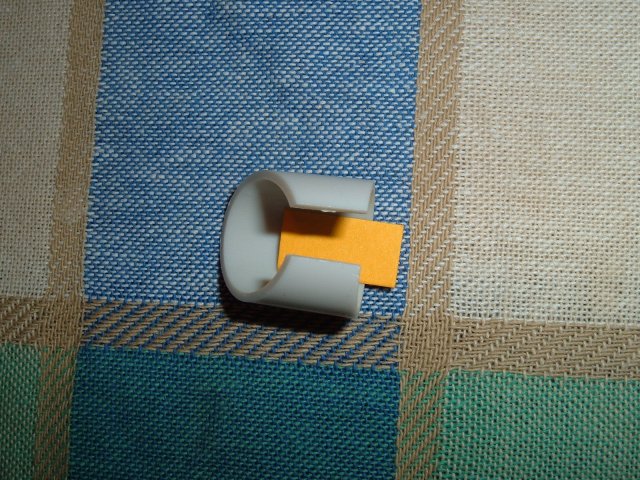
Grooved Holes
In his excellent (flute pages, a gentleman called Rick Miller suggests a technique for improving the feel of a PVC flute under one's fingers. His technique consiss in chamfering, i.e. grooving the holes.
I tried this techinque on my whistles, with interesting results. As shown in the picture, I rolled some fine-grained sandpaper around a length of pipe. Then I used this round file to sand a groove centered around each hole. The finger pads rest more comfortably against the grooved holes.
As a welcome side-effect, the tone seems to improve a bit due to smoother holes. Tuning is not affected.
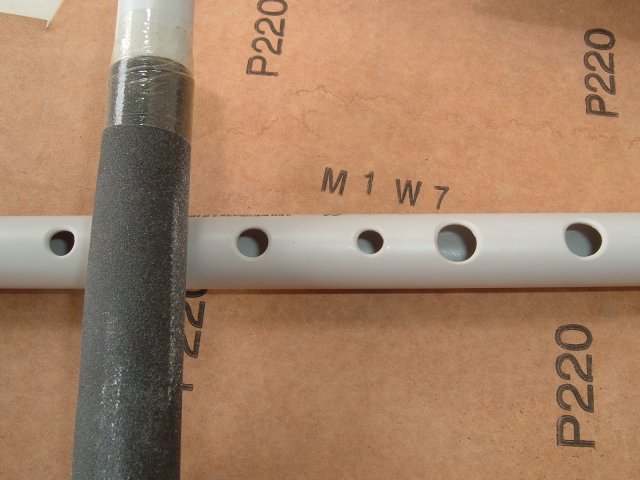
Rigging the Fipple
When you make an alto or low whistle, the fipple and lip need an important modification:
- you may sharpen the lower edge of the lip, too, to make the sound less breathy;
- this time you may bevel the fipple block (see figure) to make the bottom notes stronger. The beveling should not exceed 1.5 - 2 mm for altos, 2 - 3 mm for lows.
These tricks were kindly provided by Jem Hammond. Thanks!
Make it Tuneable
Making a whistle tunable is straightforward. There are several ways I use: a quick-and-dirty hack, and two ``professional'' methods. Other methods involve hot air guns or boiling water, which may work on some pipes. It didn't work on the PVC pipes I tried, but you might be luckier. Here is what I do:
Using Poster Putty
This method is only effective if your whistle is slightly sharp to begin with.
While playing a G, slowly slide your finger over the whistle window. The sound will go flat, then the volume will start to decrease. Modifying the window size is the simplest way to tune a whistle.
Using a small ball of poster putty to partly cover the window will do the trick:
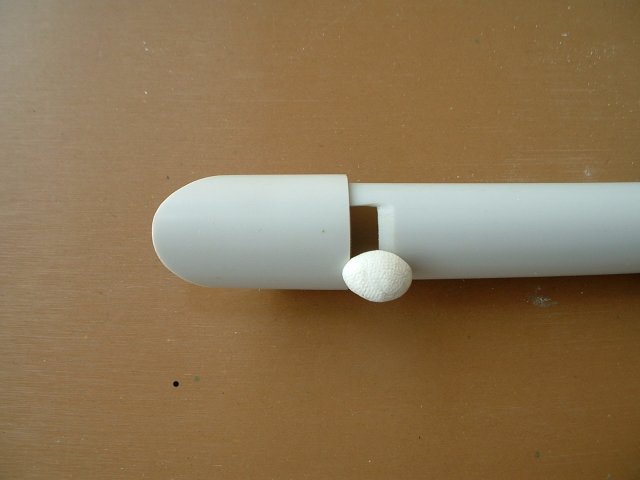
Using a Tuner Pipe
With a bit of luck, you should be able to find some plastic pipe with bore equal to the outer diameter of your whistle. Cut out a 3 or 4 cm long piece, which we shall call the tuner pipe. Then - highly traumatic moment! - saw your whistle in two parts, halfway between the lip and the uppermost hole. Insert the two whistle parts in the tuner: if they fit tightly, you're done; otherwise, roll some adhesive tape around the whistle ends. I actually glue the upper part and tape only the lower part for better stability.
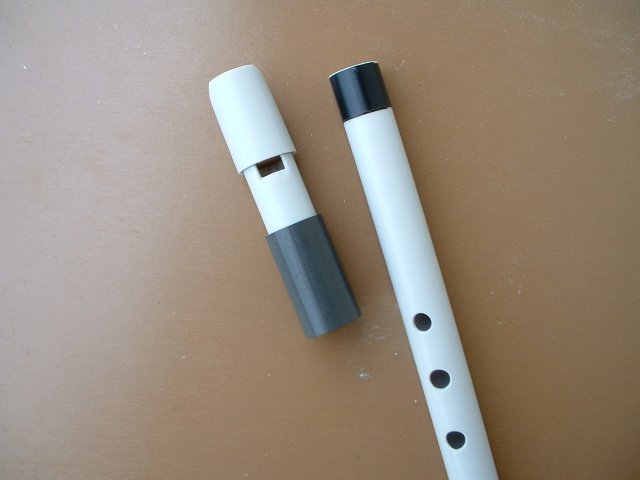
Pipe connectors are usually available for any pipe size. I tried with the ones available in Italy but they didn't work well for me, because they have slightly conical bore. Again, you might be luckier than me.
Using Acetone
A piece of PVC pipe can be softened and expanded by soaking it in acetone. A 1-litre can of acetone costs around 5 Euro.
After half an hour or more in acetone, PVC turns to soft rubber and expands. When the pipe has expanded enough, wash it under running water, then fit another piece of pipe in the expanded section. I recommend that you apply some cork grease and/or wrap some paper around the pipe.
It takes several hours for PVC to harden and shrink back a bit, possibly up to two days or even more. At the end of the process, you will get a tight fit between the two parts. One of them will become the whistle head, the other the whistle body. Never leave the two parts separated for long, because the expanded section may shrink too much.
Apply some cork grease again, and enjoy your tunable whistle. Also, bear in mind that acetone removes plumbing marks quite easily.
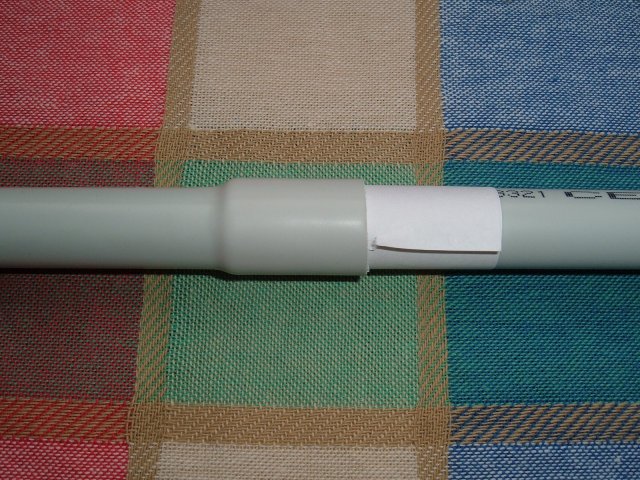
Tips and Tricks
Reducing Building Time
I spend most of the time shaping the fipple block. If you manage to find wooden (or plastic) sticks that have the same diameter as the bore, you'll save yourself a lot of work. You may ask a carpenter who has a turning lathe.
Furthermore: if you have a drill press and the right bits for wood, boring the holes will be a matter of minutes. The slower the drill, the better the holes.
To Glue or Not to Glue
The mouthpiece holds together even if you do not glue the fipple block and the windway top. Once you've played the whistle for a while and are satisfied with its sound, you may glue the fipple block into place; but if you don't, you'll be able to adjust the fipple block position as needed.
I strongly suggest that you do not glue the windway top. By moving it closer to the lip, you'll be able to make the whistle quieter; moving it farther will make the sound breathy.
Preventing Condensation Build-Up
The curved windway is, by design, less affected by the well-known moisture effect. I have never had one of my whistles clogged by condensation, but the wooden fipple block does absorb some moisture. As a result, the space under the lip space reduces and the whistles looses volume.
The problem is easily solved if you apply some cork grease on the fipple block top. Cork grease, commonly used for woodwinds, is cheap and is available at any music store. Remove the windway top, grease the fipple block, then put the windway top back on.
A better method is boiling the fipple block in melted candle wax for a few minutes. Air and humidity will be replaced by the wax, which is impervious to moisture. If you choose this method, beware: some types of wood will shrink! This can be an advantage and save you some sanding.
One Head, Two Whistles
The same mouthpiece can be used for two whistles, one in D and one in C:
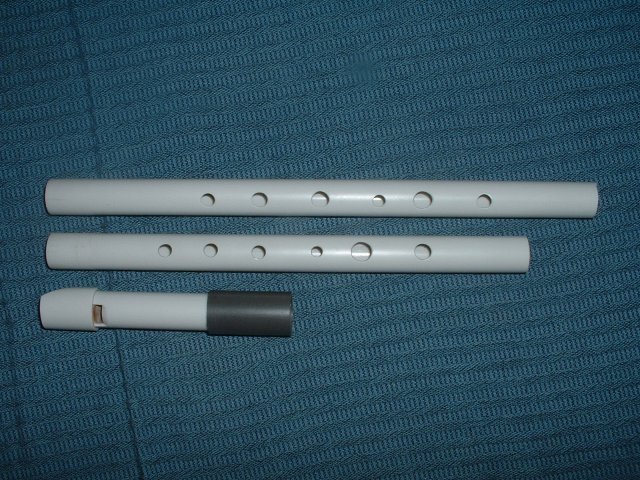
Troubleshooting + FAQ
Although I bet your first whistle will be a perfectly playable instrument, errors might occur; or you may want to make some improvements. These are the most common cases.
The sound is too weak
- Most likely, there is not enough space under the lip. Please check if fipple block has the correct size as shown in this figure.
- Perhaps the window is too small? Do not make the lip narrower than 6 mm, unless you want a whistle for playing at night while people sleep.
- Is the bore at least 9 mm?
- Did you sharpen the lip right? If you sharpened the lower edge of the lip, you'll have to blunt it slightly with fine-grained sandpaper.
- Did you blow sawdust and PVC bits out of the windway?
Lower octave notes flip into the second octave too easily
- The fipple block is too close to the lip. Move the fipple block and the windway top a bit farther away.
Second octave notes are shrill and flip into the first octave
- Most likely, the fipple block is too far from the lip. Move the fipple block and the windway top closer to the lip.
- There could be too much space under the lip. Check it out; if it is the case, replace the fipple block.
Second octave D and E tend to flip a fifth higher
- Most likely, the fipple block is too close to the lip. Either adjust the distance between ther fipple block and the lip, or employ some breath control.
- The lip might be too sharp. Try and blunt it a bit.
The whistle is OK, but the bottom D is too quiet and a bit flat
- You need to enlarge the foot as shown in the figure below:

Remove just a little, check the bottom note, and repeat if needed. You may like to cut the foot so that its section becomes an ellipse instead of a circle.
The whistle is tuned a bit flat
- Shorten the whistle until the bottom note sounds right, then enlarge the holes as needed to adjust the tuning. Start from the bottom holes. As a side effect, the whistle will also become louder.
All notes are OK, but the first octave E is too quiet
- The bottom hole is too small. I'm afraid this is the only mistake that may force you to make another whistle. If you enlarge the hole, you'll increase the volume of the E note but also affect the tuning.
How do I cut the 45 angle for the fipple/pipe/cap?
I wish I could get 1 Euro each time people ask me.
Simple answer: just try. Good ol' trial and error. There's no trick!
My pipe is thicker/wider/narrower
If you can't find PVC pipe having the very same geometry as mine, don't worry:
- whistles made with thicker pipe will sound very slightly flat. Enlarge the finger holes, or move them downwards;
- whistles made with wider pipe will be shorter than indicated in the plans. Find out the right length, then recalculate the hole positions;
- whistles made with narrower pipe will be longer than indicated in the plans. Find out the right length, then recalculate the hole positions.
What about a thumbhole?
In my opinion, it's a dumb idea.
A thumbhole is used in recorders to get notes in the high register, but whistles are smarter in this respect: just blow harder. A thumbhole is completely redundant in a whistle. So, why bother?
It sounds a bit like a recorder
Excellent! Aren't you happy?
Seriously, if your whistle has a recorder-ish sound, all you have to do is slightly blunt the lip.
Could you explain better how to...
Sorry, I can't.
I tried to write the instructions as clearly as I could, but I have only a limited command of the English language, and I'm afraid I can't explain how to make a whistle any better than I did. (Come to think of it, I couldn't write better explanations in my native language (Italian), either.)
To put it bluntly: if you don't understand something, tough! You should seek help from whistle forums, such as a Chiff and Fipple. Besides, the purpose of this guide is to encourage everyone to experiment, not to encourage everyone to ask me...
Can I make a flute using your whistle plans?
Sure you can; but you will get a very poor flute. Unless it is corrected using a special device called the Fajardo wedge, cylindrical pipe is not good for transverse flutes or fifes; the second octave sounds too flat.
Good manual, but I still have a question
Every now and then, people ask me how to make a whistle that plays in the Gyzragyan or Putzyculian scale; or how to implement alternative fipple design; or about very long or thick pipe, hyperbass whistles, alternative materials, whistle-like instruments, or to solve weird problems, and so on so forth.
If it's not already explained in this guide, I'm afraid I'm totally helpless! Please don't expect me to be a guru with the ultimate question to every aspect of instrument making. I'm just a poor lad who happened to write a simple how-to guide, but that's all. :-)
Why are you giving away your instructions?
Or, as some people put it: ``Excellent instructions, why didn't you patent your building method?''
Patenting the whistle? Are you kidding?
I believe that sharing is one of the things that make this world a less filthy place. I have a steady job thanks to all those generous geniuses who wrote GNU/Linux and free software in general (I'm a system manager) and shared it on the net. I just gave back a little fraction of what I received.
The very idea of patenting the whistle makes me sick with laughter!
Let's Play It
Now that you have a whistle, it's time to play some music. Being a beginner, I turned to the Internet for tutorials and collections. There are lots of sites dedicated to the whistle!
I found the following tutorials very useful:
Next, I downloaded excellent tune collections from these sites:
Most tune collections are written in ABC. If you want to know more about the ABC music notation, please refer to these official sites:
I maintain the latter site, where you can find ready-to-use software and documentation.
Final Words
Since I published this guide on the net, I have received a lot of feedback. It looks like my instructions work! Here is what Kyle Stuart from California wrote me:
Guido: I just want to thank you for posting the directions on making the low tech whistles. On my third try, I was able to produce a magic whistle in the key of soprano D. This whistle cost less than a dollars worth of materials and is far superior to ANY whistle I have ever purchaced. And I have bought quite a few.
(Reproduced by kind permission. Thanks!)
I had no doubts about the quality of the sound of the LTW, but now I have a confirmation. Please read the review available at http://www.tinwhistler.com/music/reviews/srcreview.asp?keyword=lotech. Many thanks to the Wandering Whistler for the review.
A review of my Low-Tech Low D was published on Chiff and Fipple.
Also, I was flattered when Keith and Sandra from Canada wrote the following:
I'm *shocked* at your suggestion I should tell my friends I'm playing "a piece of electrical conduit". They and I already refer to your progeny as "The White Lady of Verona". She is never far from my lips. She is so shapely, light and responsive; even more so after a few minutes of warming up... She loves to play and has captured my heart and mind. I can't keep my hands off her...
(Reproduced by kind permission. Thanks!)
Please let me know what you think of this tutorial; suggestions are always more than welcome. And if you make a whistle you like, I'll be glad to hear it!
All the information in this guide may be freely used for any purpose. If you sell whistles you make using my directions, good for you! But I ask you to play fair and give me proper credit. Please point your customers to this page... and send me one of your whistles for my collection.
Mission Accomplished! (For real!)
Wayne Hubin from Watertown, Minnesota, wrote me some of the most rewarding feedback I could hope for:
I'm sending this note to thank you for the whistle design and detailed and comprehensive instructions provided on your web site. I work with orphan children in Russia with a team of Americans that I lead each year. We do many things with the children and this year one of the projects I wanted to do was whistles for the kids (65). Imagine my delight when I came across your web site. In short, I ended up making 80 whistles (4 models) and had the children complete and decorate them at the orphanage. Trust me it was quite a chorus. I also made 6 different models for my own use as well. Thank you for making this project possible.
Draven Blaze from Kentucky moved me to tears as he wrote:
Thank you so much for being so generous as to go through the though and effort to learn how to make the LTW and then give the instructions away.you have given this disabled Veteran an activity that i can do with my kids where I'm unable to others.Words can't say how much you have made me happy.
This is the ultimate reward I could ever dream of!
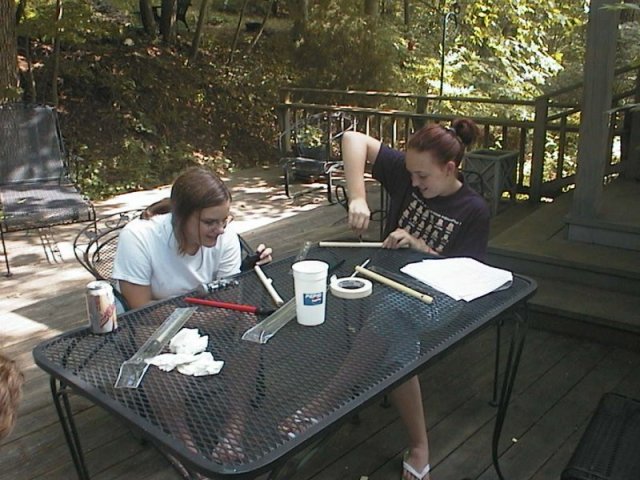
Whistle making at the "Grandkids Week". By kind permission of Jim Berry, the pretty girls, and their moms.

Whistle making at Auriville, India". By kind permission of Julius Schretzmann.
 To contact me, drop me an email: guido.gonzato (at) gmail.com
To contact me, drop me an email: guido.gonzato (at) gmail.com
Figures were drawn with XFig.
Proofreading kindly provided by Simon Bidlakecorser.
This document is released under CC BY-NC-ND 3.0 license,

Last updated: October 3, 2016
 Versione italiana
Versione italiana 

















